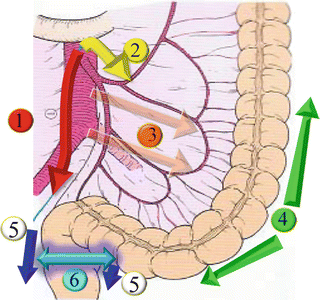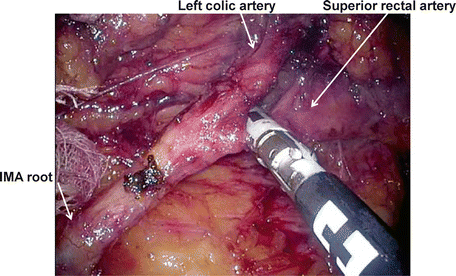Fig. 28.1
Set-up. (a) Body position. (b) Port positions
28.5.2 Port Position
A single intraumbilical 25-mm incision is made, and a multi-access platform (MAP) is inserted. Nowadays, we tend to use the EZ-access™ (Hakko Co., Nagano, Japan) MAP: The umbilicus is the only point of access to the abdomen for all patients. Three 5-mm ports are placed in the EZ-access™ (Hakko) (Fig. 28.1b). According to our clinical experience, the distance between each port must be at least 2 cm so that SPLS can be performed comfortably. The operator usually grasps forceps with the left hand and LCS with the right hand. A camera assistant must work on the left side of the surgeon to reduce the incidence of interference between the operator’s instruments and the camera during the surgery (Fig. 28.1a).
28.6 Surgical Procedure
SPLS is principally performed with the use of standard straight laparoscopic instruments (Fig. 28.2). The tumor is exteriorized through a small umbilical incision covered with a wound protector. Anastomosis is performed laparoscopically by means of the double-stapling technique.


Fig. 28.2
Surgical steps
28.6.1 Medial-to-Lateral Approach
The working space around the inferior mesenteric artery (IMA) must first be secured by fully mobilizing the small intestine toward the cranial space. The surgeon then gently grasps and lifts the IMA ventrally using forceps held in the left hand. The left colonic mesentery and mesorectum are mobilized by a medial-to-lateral approach, keeping the superior hypogastric plexus and proper rectal fascia in view and preserving them with the aid of LCS or laparoscopic bipolar scissors held by the right hand (Fig. 28.3).


Fig. 28.3
Medial-to-lateral approach. The left colonic mesentery is mobilized by a medial-to-lateral approach, preserving the superior hypogastric plexus with the aid of LCS or laparoscopic bipolar scissors held by the right hand
Tips for Maintaining the Working Space
In CLS, the operator concentrates only on lymph node dissection around the IMA because the assistant surgeon can maintain the working space by grasping the IMA gently and lifting it ventrally. In SPLS, however, the operator must perform lymph node dissection while securing the working space himself. Therefore, in SPLS, the operating table must be fully tilted so that the patient remains in the steep Trendelenburg position. This keeps the intestines from interfering with the working space. Large gauze is also useful for maintaining the working space when it is placed at the left side of the IMA.
28.6.2 Lymph Node Dissection Around the Root of the Inferior Mesenteric Artery (IMA)
In patients with advanced-stage cancer, the root of the IMA is exposed with LCS, and the IMA is sealed and divided along with lymph node dissection with a LigaSure™ (Covidien) vessel sealer. In patients with early-stage cancer, the superior rectal artery is sealed and divided to preserve the left colic artery (Fig. 28.4). The LCS is also useful for hemostasis during lymphadenectomy.


Fig. 28.4
Lymph node dissection. The superior rectal artery is sealed and divided to preserve the left colic artery in cases of early-stage cancer
28.6.3 Division of the Inferior Mesenteric Vein (IMV)
The IMV is sealed and divided at the level of the IMA stump with the use of a LigaSure™ (Covidien) vessel sealer (Fig. 28.5). The working space is then expanded. Great care must be exercised to prevent injury to the left colic artery because this vessel usually lies close to the IMV. Absence of bleeding contributes to maintaining a good working space and a clear laparoscopic view, especially when performing SPLS. Identifying the subperitoneal fascia is very important. This serves as a landmark for preserving the underlying ureter and gonadal vessels.










